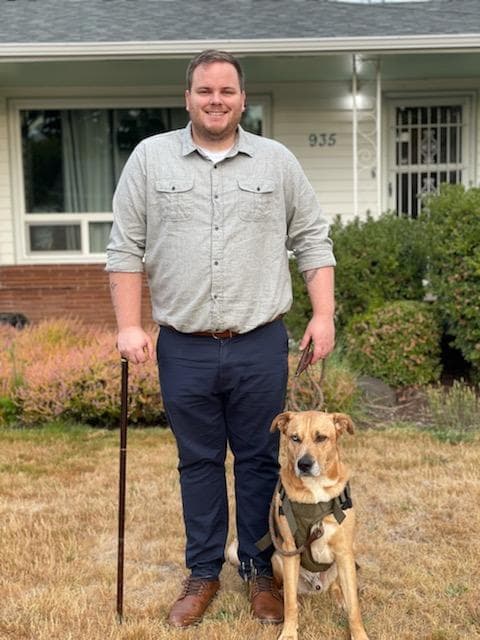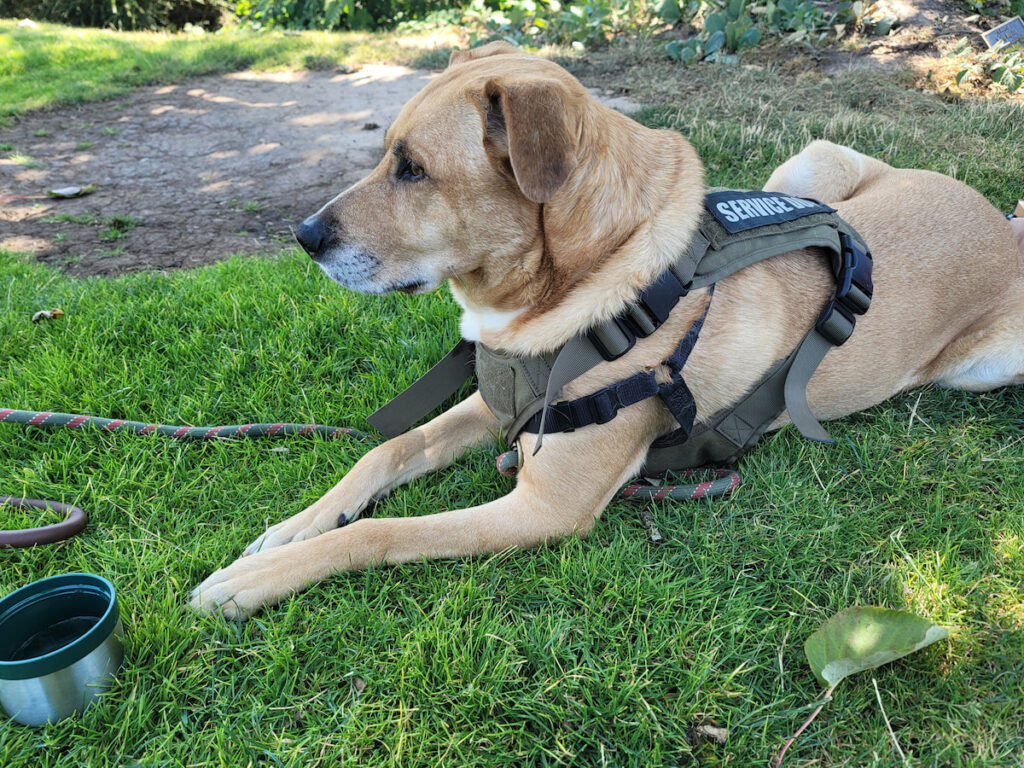Service Dogs for Seniors
“Service Dogs for Seniors” was written by Will Soyster & reviewed/edited by Aly Bouzek, MS, RDN. Will is a dietetic intern at Oregon Health and Science University.
Service dogs are incredible for the health, wellbeing, and stability of their handlers.
Seniors and their caregivers could benefit tremendously from the medical aid of a service dog. Though, beginning the process of getting a service dog can be extremely daunting.
The world of service dog information is immense. But, this blog article is here to be an introduction to the process and to provide some direction on how to begin your journey. Follow along below!
Will’s Experience with Service Dogs

This blog article was written by Will Soyster.
Will received his service dog, Wesley, in 2018 from the Animal Rescue Foundation’s (ARF) Pets and Vets Program, in Walnut Creek, CA.
Will and Wesley completed their 10 month training course at the top of their class.
After which, they continued volunteering with ARF and helping other veterans navigate the program themselves.
Wesley attended university and classes with Will as he completed his undergraduate degree at San Francisco State University.
What is a Service Dog?
A service dog can be an incredible companion, but there is much more to a service dog than its ability to comfort.
Service dogs are actually trained to perform specific tasks to aid in a medical condition or disability. For seniors, this can be an invaluable resource.
Although a service dog can be a welcome addition to the home, and deep emotional bonds can be formed between the service dog and its handler, it’s important to remember that a service dog is not a pet. It is a medical tool.
At first thought, that may sound cold or calloused but it’s important to remember this while engaging with a service dog.
Again, they have a job to perform. When they are working, they are not a pet but rather a vital medical tool for the wellbeing and social integration of the handler.
Are Emotional Support Animals the Same as Service Dogs?
An emotional support animal provides emotional comfort and stability to their owner. However, they do not perform specific tasks.
An emotional support animal may help to reduce anxiety, provide comfort in stressful times, or be a warm snuggle buddy on a hard day. These are not specific trained tasks.
Though an emotional support animal can be a helpful tool for the wellbeing of its owner, it has not been trained to perform a specific task to aid in a medical condition or disability.
The distinction between comfort and a medical task can be hard to distinguish at first. For example, if an emotional support animal provides me comfort and reduces my anxiety, isn’t that a task it is performing?
Actually, no, it is not. Their existence provides comfort, but the animal has never been trained to perform those specific tasks.
Service Dogs for Seniors: Tasks
Service dogs for seniors can provide an endless number of tasks. The sky truly is the limit. However, the task must be specifically trained to treat a specific condition.
For example, my service dog, Wesley, has been specifically trained to pick up items that I drop and hand them back to me, without chewing. (While in the Army, I injured my back, and now have limited mobility and range of motion).
In this example, my service dog was:
- trained to recognize a dropped item
- trained to recognize the dropped item is not a toy
- trained to pick up the item
- trained to place it in my hand
These specific tasks were trained over weeks of consistent training sessions.
However, there are many other potential tasks a service dog can perform. For example:
- Reminding the handler to take medications at a specific time
- Dialing 911 in the case of an emergency
- Alerting the handler of an oncoming seizure
- Alerting the handler to a drop in blood glucose levels
- Body blocking, or positioning themselves between the handler and other people
- Alerting to dissociative episodes and bumping, or nudging, the handler to return them to consciousness
While this is by no means an extensive list of tasks, it does highlight the wide range of specific and trainable tasks that a service dog can perform.
If you are unsure about what tasks a service dog might perform for you or a loved one, a reputable service dog organization in your area may be able to help. You don’t have to have everything figured out right away!
Service Dogs for Seniors: Best Dog Breeds

The truth is, there is no “best breed” when it comes to service dogs.
It truly depends on the needs of the handler, and the tasks the service dog will be trained to perform.
For example, if a senior handler was diabetic, then their service animal would be trained to smell a drop in their blood glucose (blood sugar) levels.
For this specific task, it would be best to choose a dog breed with a strong sense of smell.
Here, a beagle would be much better suited to this specific task than a pug (who has a poor sense of smell).
All breeds of dogs can perform and excel as a service dog.
The key is to recognize the medical needs of the senior handler, and to make informed choices that are compatible with the dog breed. Again, a reputable service dog organization can help in this process.
Where to Receive a Service Dog?
There are many reputable organizations all across the United States, and the globe for that matter, who specialize in training service dogs.
While the end result is the same, many organizations differ in their method of training.
Some organizations will completely train the animal independent of the handler. Then, when an applicant (or senior handler) requests a service dog, the organization will choose one of the trained dogs which fits the applicant’s needs.
Another organization type will allow an applicant to bring their own dog to be trained into the role of a service dog.
While it may be appealing to bring a family pet, or a specific dog to be trained, this does make the training a bit harder. This is because the dog must unlearn its past behaviors and family routines while also learning its new service tasks.
Other organizations, like the one where I received my service dog, Wesley, will adopt dogs from animal shelters that euthanize.
They will then assess the dog’s personality to ensure they have the right temperament for service work, and then train the handler on how to train the dog.
This organization model is my personal favorite, because a service dog is only as good as the consistency of its trainer.
It’s important for the handler to understand their responsibilities and learn consistency in their interactions with the service dog. At the end of the day, a service dog is still a dog. And dogs love to get into trouble if you let them!
Important: Service Dog Scams are Real
If you have decided that a service dog would be a good fit for yourself or a loved one, then it is important to be aware that people make a living off of scamming and tricking people. (Especially when those people are in a position of vulnerability).
Deciding to receive a service dog can be a difficult choice, and some people will take advantage of the confusion and emotions surrounding your decision.
There are many websites claiming (for a fee) that they will register your dog as an “official service dog,” or will ask you to place your dog’s name on the “official service dog registry.”
Watch out: these websites are a scam. There is no such thing as a “service dog registry,” nor is there any type of “service dog identification card.”
If you encounter any of these websites while researching service dog organizations, then you should immediately leave the site.
Remember: no matter how convincing or credible the website looks, if they request a payment online and tell you they will certify your dog, it is a scam.
Watch out for yourself and your loved ones when trying to receive a service dog. Follow my steps below to help ensure your safety and success in this process.
Service Dogs for Seniors: Receiving a Service Dog
Step #1: Get a Letter From Your Doctor
The first step in receiving a service dog is to speak with your doctor. Have them sign a letter stating that you would benefit from the assistance of a trained service dog.
Sometimes, a doctor might be unfamiliar with the service dog process, and be hesitant in writing a letter. This was the case when I received my service dog.
Try not to worry. Organizations can provide you with template letters and advise you on how to approach the topic with your doctor.
If you run into difficulty with a provider, then it might not be that they don’t think you could benefit from a service dog. But rather, they are unfamiliar with the process and might be unsure of how to proceed.
Step #2: Find a Local Service Dog Organization
The next step is to research local organizations, and find one that works best for you.
Many organizations operate as a non-profit and do not charge for their services. Meaning, you could receive a service dog without cost. (Note that this is not the case with all organizations).
Once you have found a service dog organization that you like, call or email them with any questions you might have. They will be able to tell you about their specific training styles, philosophies, and the general timeline for their particular program.
Step #3: Submit an Application
Finding a service dog organization that you like is only part of the process.
The exact process to submit an application will vary depending on the organization you choose. Be sure to follow the instructions for your choice of service dog organization, and contact them if you need additional help.
Step #4: Complete Training Through a Service Dog Organization

The last step to receiving a service dog is to complete your training.
Again, this may vary by the organization, but most will have some type of training course required for you and the service dog you are placed with.
Even if the organization you work with completely trains the service dog for you, it is critical that the senior handler understands how to maintain the service dog’s skills and how to interact with the public.
Many people in the general public might not understand what is acceptable and unacceptable behavior when they see a service dog.
So, it is the responsibility of the handler to have well-practiced responses to interactions they might encounter.
Interacting with the public is an extremely important topic, so be sure to make a plan with your service dog organization and practice it often.
Service Dogs for Seniors Conclusion
A service dog trained to perform specific tasks can be an incredible medical device that enhances the wellbeing of its senior handler.
While in the beginning it can feel daunting, it becomes much easier with the help and guidance from a service dog organization.
If you feel overwhelmed on your journey to working with a service dog, just remember to narrow your research to service dog organizations in your area. Once you have found an organization, they will be able to easily guide you through the rest of the process.
It can be an exciting and nerve-wracking experience to begin your service dog journey. Just remember that the benefits of living a more complete life far outweigh the anxiety of the unknown.

The right service dog goes a long way in not only helping seniors in their tasks but providing them with comfort as well. Great insight shared!